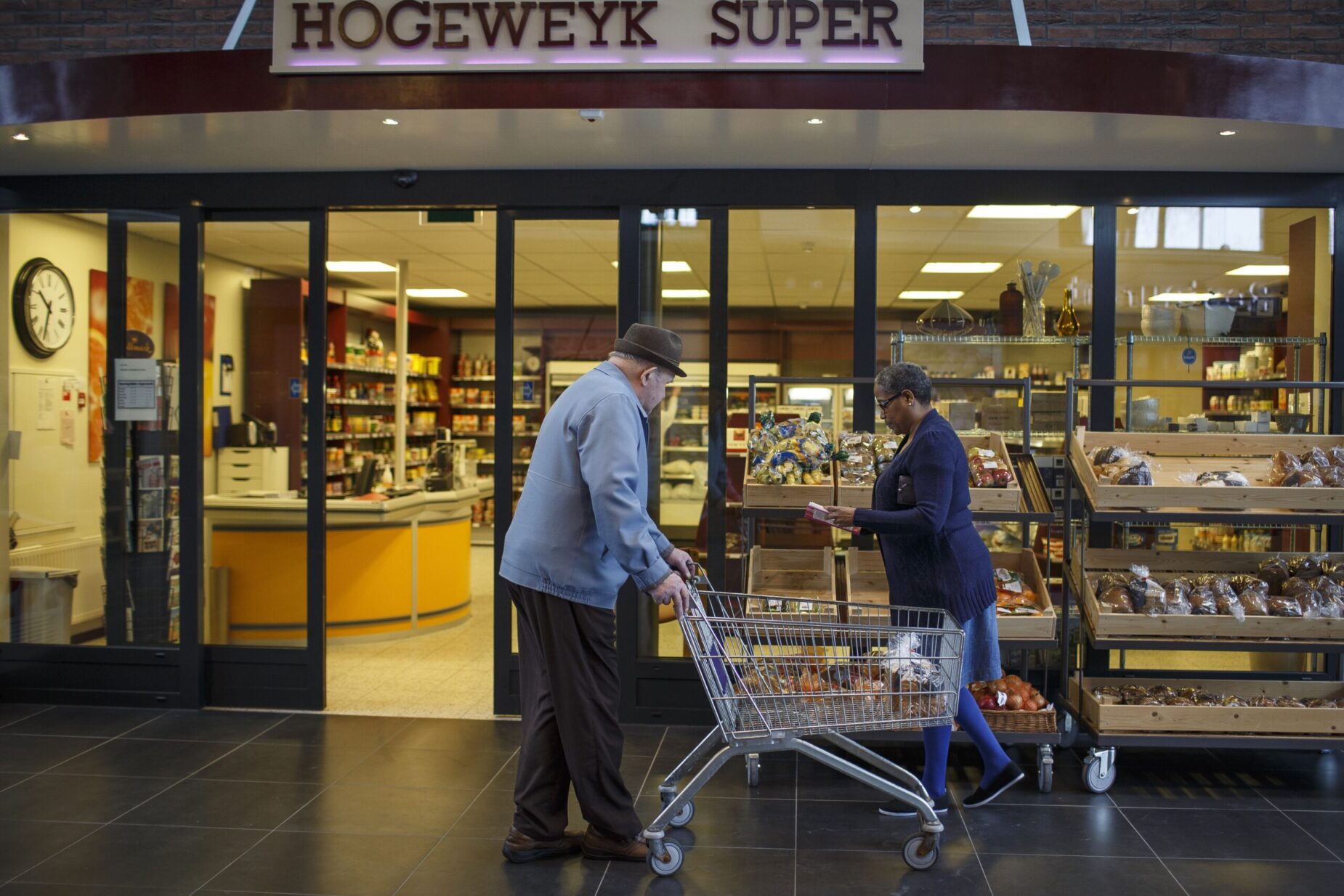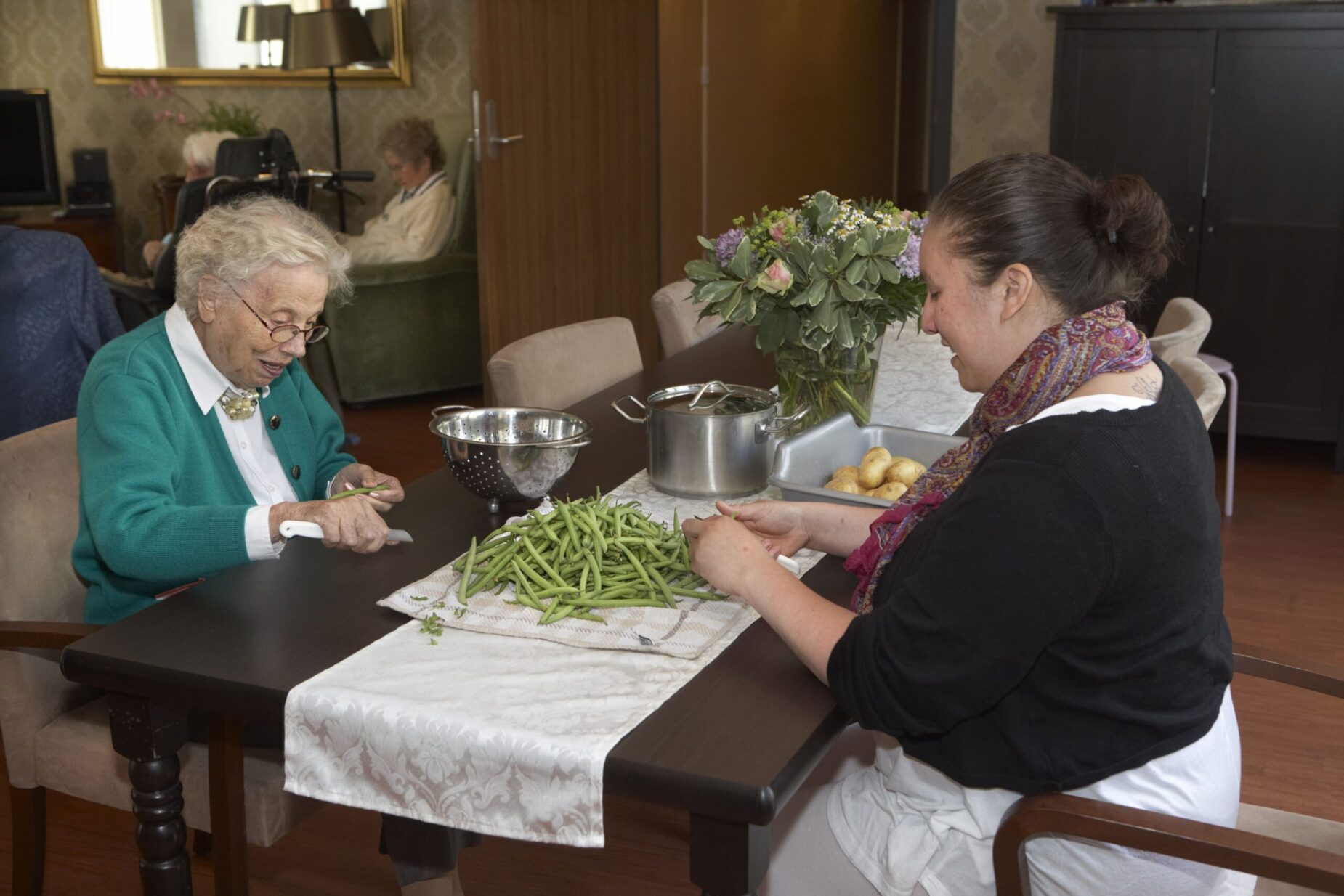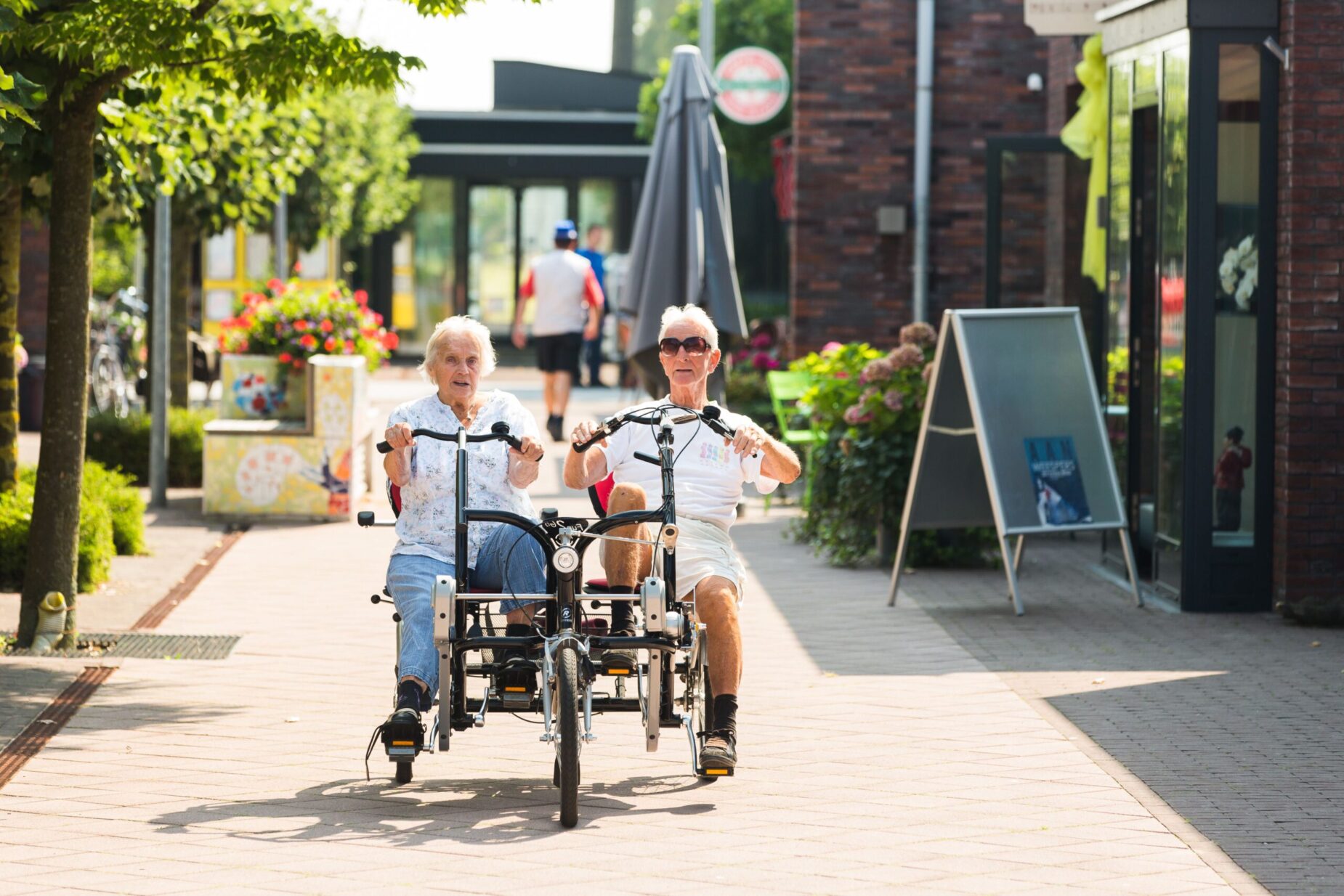It’s one of those crisp, blue, December mornings that are somehow both cold and warm at once. The sun is out, but my nose insists on remaining obstinately cold. Standing in the shade, I look over with some measure of envy at an elderly lady seated across the plaza – she has quite deliberately positioned her chair directly in line with the sun. Illuminated, she is clearly in a state of bliss, basking in the sun’s glow.
You can tell it isn’t her first rodeo out by the pond. She has set up shop in a prime people-watching location – providing me with what I imagine to be a vision of my future – where she has an optimal view of the entrances to the pub, restaurant, supermarket and theatre. Around her, people of all ages bustle about as they chat with friends, push trolleys full of shopping, drink coffee and maybe stop to look at what the theatre has on offer. She is taking it all in through squinted eyes, shamelessly sussing them all out. She catches my eye and her mouth cracks into a cheeky grin. “Goedemorgen!”, she cheerily shouts over, gesturing with one hand and balancing her walking stick on her lap with the other.
As we wave back, Janette Spiering, the founder of the care facility I am visiting, laughs. “Ah, she’s doing her morning properly.”
I’m at Hogeweyk, colloquially known as the Dutch “dementia village”, located near Amsterdam. It’s best known for housing some 169 dementia patients, to whom it awards a level of independence and a sense of normality that is unknown to the traditional model of the nursing home.
Hogeweyk, in its current form, was opened in 2009 after nearly 20 years of relentless grafting on the part of Spiering and her fellow founders, Eloy Van Hal and Yvonne Van Amerongen. The revolutionary idea – person-centred dementia care – arrested the fascination of the public, not to mention that of governments around the world. It received coverage from CNN, the New York Times, the Washington Post and the Guardian – so it’s safe to say that people’s interests were piqued by the ground-breaking approach to the unsparing disease.
What we are doing here is quite simple: we just provide a surrounding and very professional support for people with dementia
Spiering has worked in Hogeweyk since 1993. “I was here when the vision started”, she explains to me as we sit down in the village’s handsome restaurant – an impressively chic space, with soft deep purple furnishings and high ceilings. The waiter – whose white shirt and half-apron belie the fact that he is a medical professional trained to deal with people with severe dementia – hovers above us with a goggling array of teabags. Confounded, I inelegantly pluck one out (lemon and ginger). “Well, actually, I am one of the founders of the vision”, she modestly elaborates.
Imagine being able to say that about yourself. What is it like to be the founder of a vision, I wonder? “Well, you learn how hard it is to change culture”, she points out. For these pioneers, there was not only policy backing and funding to manoeuvre. “Culture”, Spiering laughs, “is the bucket behind your ship – it slows you down”. Introducing this new form of people-centred dementia care brought Spiering, and her fellow founders, up against the kind of resistance that idealists throughout history have persistently been confronted with.
“How dare you change things?”, people asked Spiering and her fellow visionaries over 25 years ago when the idea was first seriously considered.
Hogeweyk looks and feels like a small town centre. It allows patients to walk around by themselves, it permits them to do their own grocery shopping and to cook dinner – it gives them license to continue living life as a human being. Its 27 homes, which house six or seven residents each, are divided into four different “lifestyles” – traditional, urban, cosmopolitan and formal. The tailored interiors have been designed to facilitate the residents’ transition into their new home by establishing some sense of continuity between their past and present. In essence, the facility centres itself around one specific goal: fostering its patients’ sense of normality, agency and humanity.
Walking around the care facility, I start to understand why so many journalists were drawn here in its early years – and I struggle to see what provokes the opposition that it continues to face. With the carefully conceived interior of the homes, a collection of courtyards, regular streets and squares, a restaurant, a pub, a supermarket, a theatre, a hairdressers, a physiotherapist and some 30 clubs to keep patients stimulated, the facility seems a utopia when held up against regular nursing homes.
“Well, they say that this is fake. They say that this is like the Truman Show”, Spiering explains. I think back to the plot of the Jim Carrey classic. The actor plays an unassuming salesman, Truman Burbank, who leads quite an unremarkable life on Seahaven Island. The catch? Truman’s whole life has, in fact, been constructed to form the content of a reality show, unbeknown to him. Upon discovering that nothing of his life has been real – including the death of his father, his marriage to his wife and his day-to-day encounters – he seeks an escape.
“They think that we kind of ‘create’ a world and that we play-act everyday to make it happen”, Spiering continues, gesturing to the cook in the kitchen who is kitted out in chef attire – the hat, the jacket, you get the picture. Although the chef does the usual chef stuff, he is professionally trained to care for people with dementia – as is the waiter who served us, as well as the cashier at the supermarket, the hairdresser, the bartender and all of the staff. Critics have seized upon this fact of simulation to wage their argument that Hogeweyk has, as Truman’s show executives do in the film, “constructed” a world for its patients, thereby fooling them and, therefore, mistreating them.

“Walking around the care facility, I start to understand why so many journalists were drawn here in its early years.”
I find myself grappling with the implications of this critique. By maintaining some measure of autonomy for its patients, does Hogeweyk not do the exact opposite of manufacturing its residents’ world? The entire point of Hogeweyk is that rather than imposing a prescribed version of life on its patients, it actively helps to maintain the unpredictability and integral variability of it for them.
“The people you see here are real and what they do is real”, Spiering argues. I look across the room at an elderly gentleman sitting with someone who looks like his son, and I watch as the waiter amusingly repeats the tea delivery extravaganza – you would be foolish to suggest routines of this kind weren’t, in a strong sense, genuine. “This is just the real world”, Spiering emphatically declares. “It is not a show.”
“If you think it’s artificial: well, yes, you can argue that. But if someone can’t live in their own home anymore, what would you prefer?”, poses Jacqueline Hoogendam, the acting dementia policy co-ordinator at the Dutch Ministry of Health, Welfare and Sport.
“At Hogeweyk, people are stimulated to be active and to remain active”, Hoogendam explains. The 30 clubs that residents can join, as well as seemingly menial tasks such as doing your shopping, cooking your dinner, or cleaning up after yourself are, for a person living with dementia, “meaningful activities”, she says.
Emma Van Bussell, a dementia prevention researcher based in Amsterdam Academic Medical Centre, also talks up the benefits of these meaningful activities, which she calls “cognitive training”: “If you can keep doing these things, it’s easier to keep on doing them – if you never do the dishes, well, then you won’t know how to do them anymore.”
In contrast to the risk-averse approach in standard nursing homes, Hogeweyk encourages its patients to keep moving, to keep walking – something that becomes apparent as Spiering takes me for a tour around the “village”. I struggle to distinguish between patients, visitors, volunteers and nurses. Two elderly men walk by, one pushing a trolley, the other distractedly looking around – I can’t tell which one lives here, or if both of them do. We pass by a middle-aged woman who nearly trips over herself, inexplicably – something I myself have been known to do. Then a relatively young family hurry down another street, and I find myself wondering if they’re visiting someone or if, maybe, one of the parents is a patient here – a possibility that wouldn’t even have occurred to me an hour ago.
Hogeweyk, Spiering says, preserves at least some semblance of this for its patients. “What we are doing here is quite simple: we just provide a surrounding and very professional support for people with dementia so that they can go on with their lives”, she explains. Gesturing to the activity all around us she says: “This is just part of normal life.”
It’s to build an environment that is easier, accessible for them, but also to help them to have a really meaningful way of life
“Normal” is certainly the buzzword here. Sustaining its philosophy is Hogeweyk’s motivation: to peel away the layers of othering, taboo and stigmatisation that have been wrapped around dementia. “If we are able to make people in society more aware of what dementia is, then hopefully the negative image, or the stigma, will lessen”, Spiering suggests.
If society is “not aware of what dementia means”, the disease becomes all the more frightening, according to Spiering. Indeed, there is no denying just how nettling it is to consider the possibility of the loss of one’s memory. However, that fearful feeling is only exacerbated by ignorance. While dementia is an awful, harrowing disease, what Hogeweyk is proving is that in the right environment and with the correct store of knowledge, it need not be equated with some fated diminuendo in the quality and character of a life.
A number of things occur to me as Spiering excavates the stigma surrounding dementia. Hogeweyk, it seems, isn’t just a model for nursing homes, but for society. The strangers that people encounter everyday – cashiers, waiters, bus drivers – could in an ideal world be capable of dealing with customers who are affected by the disease. In fact, any passerby could, in this alternative universe, have the knowledge to help someone who seems lost or confused. Although people have marvelled at the care facility and its “village” feel, many seem to have overlooked this point. Hogeweyk presents itself as a village not only because it aims to normalise its residents’ surroundings, but because it wants to show non-dementia sufferers what villages could feel like – safe and inclusive.
The idea that ignorance germinates fear is hardly unique to our understanding of dementia. This is a governing dictate of our lives. It’s a tendency that leads to the “othering” of those we don’t understand. Thus, Hogeweyk offers a prototype of something more than a dementia care facility. It demonstrates a world in which the cycle of dehumanisation is broken.
Under Jacqueline Hoogendam, the Dutch government’s policies on dementia seem to be working toward creating this world. In a joint initiative with Alzheimer Nederland and the pension administration organisation, the Ministry of Health, Welfare and Sport launched the Dementia Friends campaign in 2015. The objective is to provide people with the necessary training to deal compassionately and tactfully with those suffering with dementia. Today, over 300,000 people have completed the course. The campaign has encouraged service people – including taxi drivers, hairdressers and ticket collectors – to complete the free training course in order to create a “dementia friendly society”. It seems that Hoogendam’s vision for Dutch society, and the place of those with dementia in it, mirrors the hopes that Hogeweyk’s founders originally had for their facility: “It’s to build an environment that is easier, accessible for them, but also to help them to have a really meaningful way of life.”
The Dutch are often described as the “frontrunners” in the ongoing international shift in dementia policies. However, as Hogeweyk’s founders know all too well, this hasn’t always been the case. “As an innovator you are always here”, Spiering says as she places one hand at metaphorical point A, “and policy is there” – shifting her other hand to a metaphorical point B. “You always clash.” This explains the two decades that had to pass before Hogeweyk’s vision was realised.

Hogeweyk awards a level of independence and a sense of normality that is unknown to the traditional model of the nursing home.
Yet in recent years, it seems that Hogeweyk has offered inspiration to its national government. The Dutch currently lead the way in the European Joint Programme for Neurodegenerative Disease Research. Moreover, Hogeweyk has been a catalyst in the establishment of more facilities of its kind around the Netherlands, as well as for the opening of care farms, which fuse healthcare and agriculture together. The country’s ever-evolving set of progressive policies is geared towards coping with what Van Bussel calls the “rising” levels of dementia (in the Netherlands, some 25 per cent of those over 80 are expected to fall victim to the disease).
These major advancements, made in part due to Hogeweyk’s perseverance, have acted as the blueprint for further progress all around the world. In fact, its effect can be seen in Ireland where we have our own iteration of care farms and, indeed, person-centred dementia facilities, either established or in the pipeline.
Colette Ryan is the general manager of the Carebright dementia home in Bruff, Co Limerick. Over the phone, she tells me about the challenges its management faced when opening Ireland’s first purpose-built facility for people with dementia in 2018: “At the very start, there was a defence – what were we doing, why were we doing it, all of that.“ Carebright’s founders, like Hogeweyk’s, didn’t just have to surmount the difficulties posed by severe funding strains and lacking policy support – they also found themselves tasked with the hefty job of “changing the mindset of everybody”. “We had to break down stigma”, says Ryan.
How, I ask, do you go about breaking down a stigma? ”Oh my god, it’s very hard”, she exhales.
Central to Carebright’s success, it seems, has been its openness, of which its cafe is the prime example. Open to the public seven days a week, the Yarn Cafe has helped remove a barrier that prevents people from engaging with the realities – both good and bad – of the disease.
Over the past two years, Ryan and the rest of her team at Carebright have had to grapple with the ambiguities of forging a system for which there is no precedent. “It’s up to people like ourselves to prove the model”, she explains. And it seems that they are managing to do just that, with the Memory Care Village at Oaklodge Nursing Home in Cloyne, Co Cork, set to open this year.
They say that this is fake. They say that this is like the Truman Show
Although people-centred dementia care has its critics, and there are a lot of questions to answer, I wonder if such criticisms can really outweigh those we should have of the longstanding model of dementia care.
I consider this as I visit my own gran in her nursing home. Each time I visit, I find her in a relatively small sitting room with 15 or 20 other patients. For many of them, that trip from their bed to the TV room is the most exciting thing that will happen all day. Mass on Sunday is considered “something to do” and they all seem to have grown used to the idea of being constantly under surveillance.
“Oh, back to Mountjoy I go!”, my gran will tease as we return her to the home after a day out. She jokes, but the sentiment is no less stinging. While the care in the home is delivered with the very same tenderness as it is at Hogeweyk, it is still delivered within a certain system. In Hogeweyk, Spiering says that “the life of a resident should come first, and a system should wrap itself around it. Not the other way around”. I find it hard to disagree, as I walk through the one-tone building my gran now calls home.
And maybe this is why I was so taken with Hogeweyk. Even if I one day have a terrible disease that means I no longer recognise myself or those closest to me, or understand why this person is standing in front of me with so many tea bags on offer, I want life to retain its incalculable qualities, its diversity, its allure. I want it to remain intriguing.
Places like Hogeweyk exist to make sure that people like me, and the smiling elderly lady I find myself waving at on this crisp, blue, December morning, continue to draw up our chairs in the sun to simply watch the world go by.







